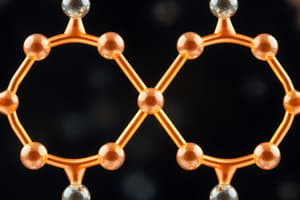Podcast
Questions and Answers
What type of attraction is responsible for the formation of hydrogen bonds?
What type of attraction is responsible for the formation of hydrogen bonds?
- Dispersion forces between molecules
- Electrostatic attraction between partial charges (correct)
- Covalent bonds between atoms
- Ionic attraction between full charges
Which compound has a higher boiling point due to the presence of hydrogen bonding?
Which compound has a higher boiling point due to the presence of hydrogen bonding?
- Ethanol (C2H5OH) (correct)
- Water (H2O)
- Diethyl ether (C2H5-O-C2H5)
- Methanol (CH3OH)
What is the primary reason for the difference in melting points between o-nitrophenol and p-nitrophenol?
What is the primary reason for the difference in melting points between o-nitrophenol and p-nitrophenol?
- Presence of intramolecular hydrogen bonds
- Differences in the number of carbon atoms
- Differences in molecular structure and hydrogen bonding capacity (correct)
- Differences in molecular weight
What determines the valency of an atom?
What determines the valency of an atom?
Which of the following compounds exhibits intramolecular hydrogen bonding?
Which of the following compounds exhibits intramolecular hydrogen bonding?
What is the bond angle in methane?
What is the bond angle in methane?
Which type of hybridization is observed in the carbon atom of methane?
Which type of hybridization is observed in the carbon atom of methane?
How many hydrogen atoms are bonded to the carbon atom in methane?
How many hydrogen atoms are bonded to the carbon atom in methane?
Which orbitals participate in the formation of methane's bonds?
Which orbitals participate in the formation of methane's bonds?
What characterizes an ionic bond?
What characterizes an ionic bond?
What is the reason for the tetrahedral shape of methane?
What is the reason for the tetrahedral shape of methane?
In which type of bond do atoms share electrons?
In which type of bond do atoms share electrons?
What type of overlap occurs in an s and p bond?
What type of overlap occurs in an s and p bond?
What is the shape of an s orbital?
What is the shape of an s orbital?
Which bond type is indicated by the combination of Na+ and Cl- to form NaCl?
Which bond type is indicated by the combination of Na+ and Cl- to form NaCl?
Which of the following does not represent a characteristic of covalent bonds?
Which of the following does not represent a characteristic of covalent bonds?
What type of overlap forms an s bond in H2?
What type of overlap forms an s bond in H2?
Which configuration results from the electron transfer in ionic bonding?
Which configuration results from the electron transfer in ionic bonding?
What is the hybridization state of carbon when it has a configuration of 2px1, 2py1, and 2pz1?
What is the hybridization state of carbon when it has a configuration of 2px1, 2py1, and 2pz1?
Which of the following statements about hybridized orbitals is true?
Which of the following statements about hybridized orbitals is true?
How many orbitals are involved in the hybridization of carbon when it is tetravalent?
How many orbitals are involved in the hybridization of carbon when it is tetravalent?
In which hybridization does carbon have the configuration of 2s1, 2px1, and 2py1?
In which hybridization does carbon have the configuration of 2s1, 2px1, and 2py1?
What does the term 'promotion' refer to in the context of electron configuration?
What does the term 'promotion' refer to in the context of electron configuration?
Which groups are identified as alkyl groups in the content?
Which groups are identified as alkyl groups in the content?
What is a key feature of resonance structures?
What is a key feature of resonance structures?
What defines the inductive effect?
What defines the inductive effect?
Which statement is true about conjugated systems?
Which statement is true about conjugated systems?
How does the transmission effect of the inductive effect behave with distance?
How does the transmission effect of the inductive effect behave with distance?
What occurs during homolytic fission?
What occurs during homolytic fission?
In what type of systems does resonance occur?
In what type of systems does resonance occur?
Which statement about canonical structures is correct?
Which statement about canonical structures is correct?
Flashcards are hidden until you start studying
Study Notes
Types of Chemical Bonds
- Ionic Bond: Formed by electrostatic attraction between positive and negative ions.
- Example: Sodium chloride (NaCl) is formed from sodium cation (Na+) and chloride anion (Cl-)
- Occurs through electron transfer, resulting in atoms attaining noble gas configuration.
Covalent Bond
- Sharing of electrons between two atoms.
- Occurs through overlap of atomic orbitals.
- Overlapping can form sigma (s) or pi (p) bonds.
- There are three types of overlap:
- s and s overlap: forming sigma (s) bonds. Example: H2
- s and p overlap: forming sigma (s) bonds. Example: HCl
- p and p overlap: forming sigma (s) bonds. Example: Cl2, p and p overlap occurs head-on due to electrostatic attraction between δ+ and δ-.
Hydrogen Bonding
- Stronger than van der Waals forces
- Association hydrogen bonding leads to increased boiling point.
- Example: Ethanol (C2H5OH, 78°C) has a higher boiling point than diethyl ether (C2H5-O-C2H5, 32°C)
- Hydrogen bonding can occur in the same molecule (intramolecular) or between different molecules (intermolecular).
- Intramolecular hydrogen bonding: Occurs within the same molecule.
- Example: o-Nitrophenol has intramolecular hydrogen bonding leading to a higher melting point than p-Nitrophenol.
Valency
- Number of electrons an atom needs to lose or gain to achieve the nearest noble gas electronic configuration.
- Carbon has a valency of four, as it needs to gain or lose four electrons to achieve a stable octet electronic configuration.
- The promotion of electrons from 2s orbital to 2p orbitals allows carbon to form four bonds by utilizing hybridized orbitals (sp3, sp2, sp).
Hybridization
- The mixing of atomic orbitals within an atom to form new hybridized orbitals.
- Hybridized orbitals have energies between those of the original s and p orbitals.
- Hybridization results in a change in the shape and bonding properties of the molecule.
Methane (CH4)
- Demonstrates sp3 hybridization
- Tetrahedral geometry with bond angles of 109.5°
- Four sp3 hybridized orbitals of the carbon atom overlap with four 1s orbitals of four hydrogen atoms.
Resonance
- Possible when a molecule has multiple Lewis structures representing the electron arrangement.
- These are known as canonical structures.
- Delocalization of electrons occurs across the conjugated system (alternating double and single bonds).
- A higher number of canonical structures leads to greater stability.
Inductive Effect & Resonance Effect
- Inductive effect: Occurs only in saturated systems.
- Relates to an atom or group's tendency to attract or release electrons.
- Transmission effect fades with increasing distance.
- Resonance effect: Occurs in unsaturated and conjugated systems.
- Delocalization of p electrons or lone pairs in a planar system.
- The effect continues as long as conjugation extends.
Breaking a Covalent Bond
- Homolytic fission: The breaking of a covalent bond results in the formation of two free radicals, each with one electron from the original bond. R Y R.+ Y.
Studying That Suits You
Use AI to generate personalized quizzes and flashcards to suit your learning preferences.




